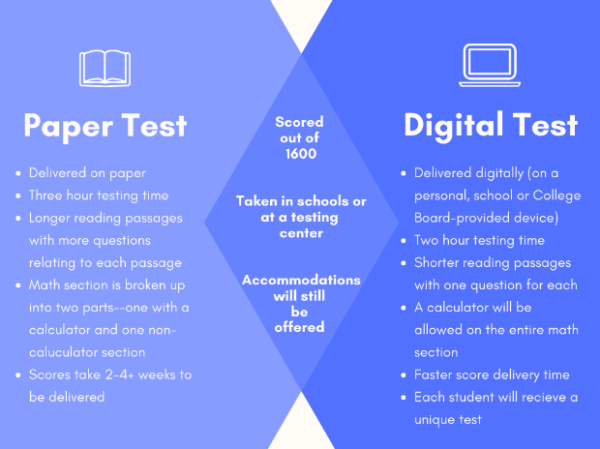Clarke Central High School College Adviser Gabriel Smallwood stands in front of various college flags holding Scholastic Aptitude Test (SAT) preparation books on Oct. 19. The SAT will have fully transitioned from a paper to a digital format by the end of 2024, an idea Smallwood supports in order to make things easier for students. “I’m for whatever will help students in terms of (getting) a better opportunity to showcase their talents and skills,” Smallwood said. “For now, I will encourage students to register for the SAT and ACT (and to) go ahead and start studying for it because the application process has opened for colleges.” Photo by Aza Khan
The SAT, a standardized test used by post-secondary institutions as a factor in the admissions process, will fully transition to paper to digital by 2024.
For almost a century, the Scholastic Aptitude Test (SAT) has been administered to high school students to showcase their academic capabilities to colleges. During this period of time, the test has always been taken using pencil and paper.
On Jan. 25, College Board – an organization that administers standardized tests such as the SAT and Advanced Placement (AP) exams – announced that at the beginning of spring 2023, the SAT delivered outside the U.S. will switch to taking place digitally. The U.S. SAT will follow in the spring of 2024, completing the shift of all SAT-related assessments to an exclusively-digital platform.
“Students will be able to complete the new online test on their own laptop or tablet, a school-issued device or one borrowed from the College Board, ”University of Georgia Director of College Admissions Barkley Barton II said. “There will be a unique test for each student, (which will provide) more security for future tests. Completing the test will take two hours instead of three hours (and) digital testing allows for faster score reporting.”

An infographic displays the differences and similarities between the Scholastic Aptitude Test on paper compared to the test online. Clarke Central High School senior Grace Habibi has taken the test twice on paper but welcomes the option of taking it online. “I think it will benefit people because I don’t think it’s as stressful,” Habibi said. “I also think it will be quicker to get your test scores since if you aren’t doing it (in) paper form, people probably have to sort through those papers.” Infographic by Riley Ramsey
Clarke Central High School Class of 2021 alumna Treasa McHugh is not surprised that the test is moving to a digital platform.
“Changing the format of the SAT makes sense to me,” McHugh said. “It may take time for people to relearn how to take and/or teach the SAT, but I think the convenience and efficiency of online testing will be worth working through those changes.”
CCHS senior Camille Hudson, who plans to take the SAT for the first time on Oct.1, believes the transition of the SAT from paper to digital will be easy since many tests and assignments given in school are already on the computer.
“I feel like we’re moving into more technology-based everything. So most tests, most things that we’re doing are already on (the) computer,” Hudson said. “It’s all about efficiency and getting it sent out to whoever. I just feel like when it’s online, it’s much faster to get the scores in.”
While she believes the transition will be easy, Hudson prefers to take tests in the traditional manner.
“Testing on the computer is straining and I would rather take it on paper. I don’t really like technology. You could have mishaps, your computer can die, you never know,” Hudson said. “Most people would probably prefer to have (the test) on paper.”
In order to test out the digital format, the College Board launched a pilot program inside and outside the U.S. in November 2021 that was meant to give the opportunity to compare paper and digital SAT scores.
“There could be students who do not like focusing (on) a computer and would not focus enough on it. That could be a potential problem,” CCHS College Adviser Gabriel Smallwood said. “And there’s some students who are not able to sit there and write on a piece of paper.”
McHugh feels the test’s transition may have a positive impact on students when it comes to the college application process.
“The sooner (students) know how they performed on the test, the sooner they know if (and) when they need to test again in order to be able to submit a score that they’re happy with to a school that they’re interested in,” McHugh said.
According to the Program Manager for Dual Enrollment at the Georgia Institute of Technology Laura Simmons, any changes to the SAT are designed to make the process of taking the test and receiving scores as smooth as possible.
“(High school) students should not worry about these changes,” Simmons said. “(The) College Board has nothing to gain from tests being harder or results being different. They will make sure the experience is as good as taking a standardized test can be.”
